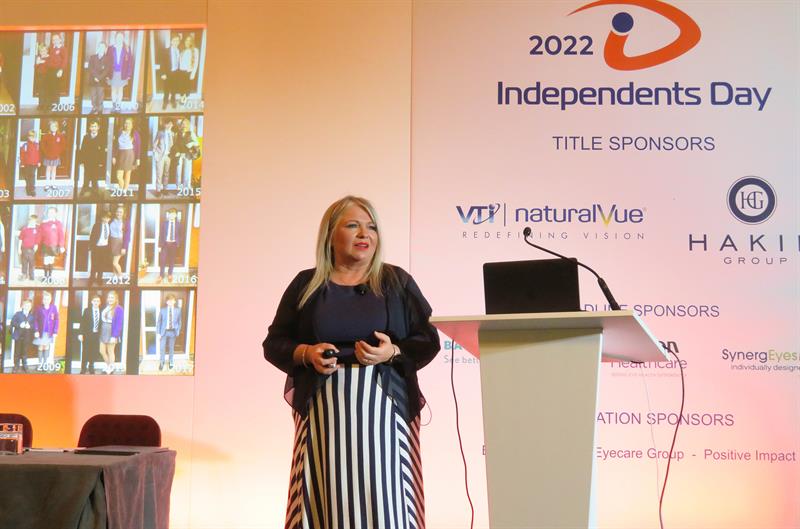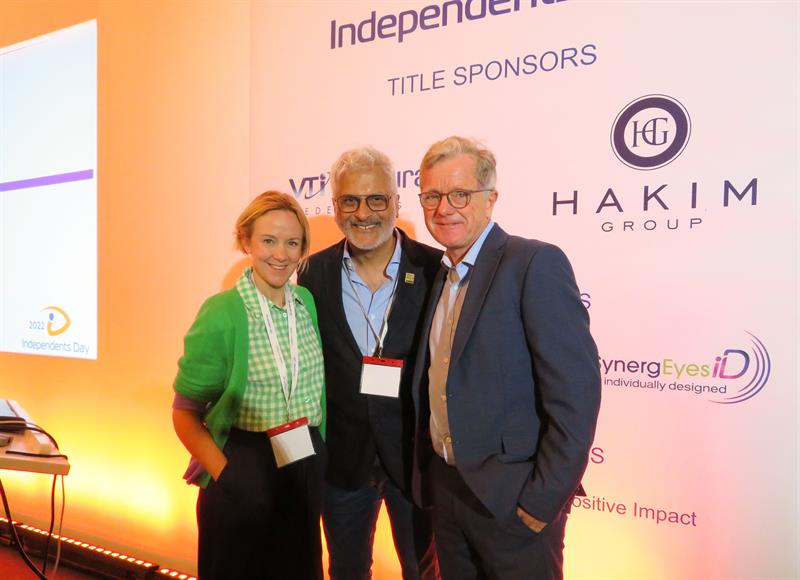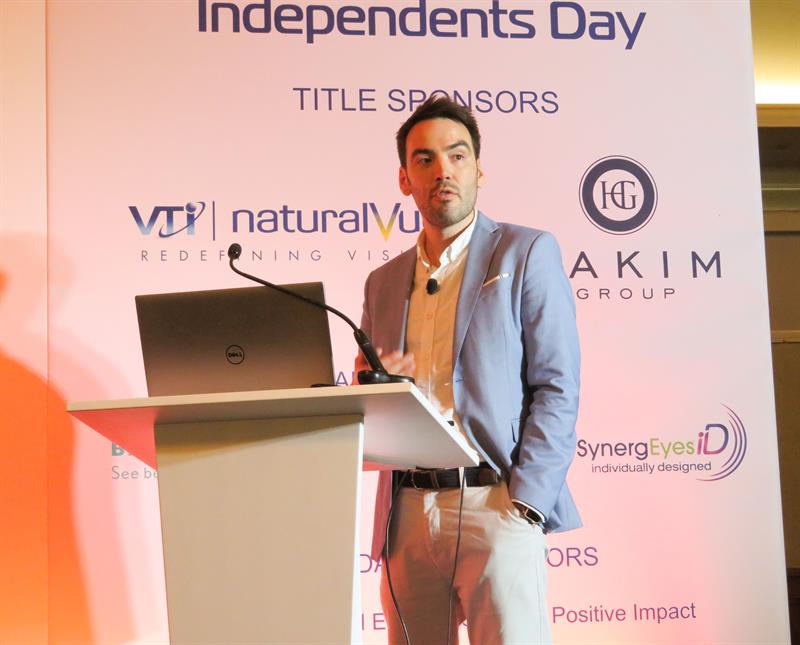
The Independents Day (iDay) 2022 Conference gathered 80 practitioners at the National Motorcycle Museum in Birmingham on July 4 to share myopia management best practices, improve marketing skills and change misconceptions around myopia fees.
Optometrist and myopia specialist, Nick Dash, began the day with a focus on the patient experience highlighted by the powerfully named session, A Once in a Lifetime Opportunity: Myopia Matters, which discussed professional duty, opportunity and the benefits from developing his website whymyopiamatters.org.
Dr Gary Gerber presented the keynote address, Commercialising Myopia Management, from the US through a pre-recorded video that outlined how the Treehouse Eyes organisation, a myopia management eye care group of over 60 practices across 22 US states, originated after he and co-founder Matt Oerding noticed a myopia-shaped gap in the eye care market. Gerber explained their effective eye care business model was based around four priorities: science, demand, solely myopia-focused services, and a proactive mindset. He said: ‘The most important thing you need to do in your practice when you start down this journey is to make sure you have the proper mindset. To succeed in myopia management, you must have a knee-jerk response. Instead of simply giving them the minus 0.75 pair of eyeglasses, you should be thinking “how can I slow down this kid’s axial length.”
‘Make sure to use as many tools in the toolbox as you can. You must measure axial length. Practising myopia management without measuring the axial length of the eye is like signing up for a weight loss programme and not having a scale. We are controlling axial elongation, so we must be able to measure efficacy of whatever treatment is being used.’
Gerber shared other lessons learned, such as investing equally in the marketing side as the science side, including extensive market research with parents and being introspective about practice systems in regard to flexibility around scheduling appointments at child-friendly times and testing out how to incorporate myopia services.
Dr. Gary Gerber filmed his presentation from the US coast

Why context matters
One of Treehouse Eyes’ biggest takeaways from market research has been the importance of understanding how to communicate the benefits of treatment, and therefore the urgency required, to different parents in order to get the best response and outcome for their child. They found that there were two common types of parents in the US and built touchpoint profiles based on these, such as the tiger mum, who prepares for the future, and the dragon mum, who lives in the moment.
Gerber summarised: ‘During our research, we distilled parents down into two profiles and we present differently to these two profiles. One profile is the quintessential helicopter parent, their goal in life is to raise perfect kids... you would recommend treatments that help give the child a competitive edge. The other profile parent has all their happiness wrapped up in the kid’s happiness, so focus on how much they’ll love the process.’

During optometrist Sarah Morgan’s afternoon session, Myopia: The Conversation Starts Here, pictured, speakers and delegates came to a consensus that myopia control is as much about managing the parents’ concerns and expectations as it is about managing the child’s condition. She pinpointed that it boils down to understanding the context. For example, ask the parents about family history of myopia, dive into the lifestyle of the child to know what treatment they would prefer, and find the influencers in children’s lives to target the best ways to spread awareness, such as through schools, grandparents and other community figures. Morgan interacted with the audience, often encouraging discussion on topics like the ideal age to begin the myopia journey – which she concluded from research to be six years old – and what games parents could play with their child to spot early signs of myopia. She explained: ‘We have to train the parents for them to track if a child has become myopic. This involves giving a level of instruction that helps the parents witness change as the child reports an onset of myopia.’
Constant exposure
Healthcare marketing expert and co-founder at Treehouse Eyes, Matt Oerding, continued business development advice with the virtual session How Not to Market Myopia Control. Oerding said the key points for myopia marketing are building parents knowledge over time through constant exposure to myopia information, talking to parents early before progression, having the basic marketing tools to boost awareness such as leaflets, strong online presence, effective social media, QR codes and use of video testimonials, as well as partnering with myopia businesses.
‘Content is king. While it’s great to leverage and you don’t have to always reinvent, video content is today’s reality. Whether you’re on a website or social media, video is what effectively sells these days,’ he said.
Oerding cautioned practitioners not to focus on the product when handing out information as parents are emotionally motivated by their child’s development, not by the technical features.
As the previous board chair for the Global Myopia Awareness Coalition (GMAC), established in 2019, Oerding shared his involvement in progressing the awareness of myopia disease. The GMAC conducted a survey of 1,500 UK parents with school-age children to measure the awareness of parents, with UK and US comparisons. This revealed that only 15% of UK parents were familiar with myopia, of which 35% said an optometrist informed them, 18% discovered through the internet and 8% via social media.
‘We have almost no awareness among parents and the reality is parents know very little about any treatment options. For parents whose children already have myopia, two-thirds of them said that their optometrist has not discussed treatment options,’ Oerding said.

During Myopia My Way, where UK practitioners Indie Grewal, Sarah Farrant and Bhavin Shah explored myopia patient cases, Grewal suggested his tried-and-tested method of spreading awareness in local communities by providing a free trial day of treatment on a day they are expecting to be social, in return for the child sharing their eye care experiences.
While the US commonly start children on contact lenses at 12 years old, the UK has shown to be closer to 18 years old, said Oerding, advising UK professionals to encourage the acceptance of contact lenses for young children as it is a form of myopia treatment.
Morgan agreed, showing personal accounts and academic research which proved children can positively benefit in their confidence, ability to interact in activities, social mobility and academic progression.
Subscription-based fees win

Craig McArthur, pictured, optometrist, director and co-owner of Peter Ivins Eye Care, presented Charging for Myopia Management, which outlined why using monthly subscription-based fees was the most effective pricing model for myopia healthcare services. The misconception around commercial unviability was raised as this was often the biggest barrier to practices starting services. ‘It involves a slight change in mindset away from profit to gross profit for pay per minutes, for example, take profit from the X treatment over a fixed period and divide by the minutes from time spent with the patient.’
He concluded that the advantages are mutually beneficial to both the family and the practice: ‘It’s a lower entry fee for families as the overall cost is spread across the year. There are no hidden fees and people are familiar with this model from things like mobile and Netflix subscriptions.’
